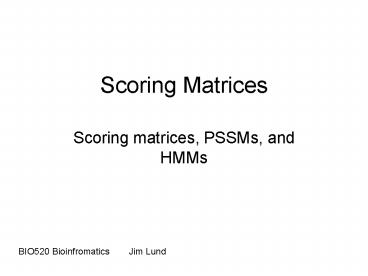Scoring Matrices PowerPoint PPT Presentation
1 / 17
Title: Scoring Matrices
1
Scoring Matrices
- Scoring matrices, PSSMs, and HMMs
BIO520 Bioinfromatics Jim Lund
2
Alginment scoring matrix
- DNA matrix
- A C G T
- A 5 -4 -4 -4
- T -4 5 -4 -4
- C -4 -4 5 -4
- G -4 -4 -4 5
3
Alginment scoring matrix
- Protein matrix
4
Use of a scoring matrix
- P L S - - C F G
- G L T - A C H L
- 111-2-1111
- Score 3
5
Consensus sequences
- Different ways to describe a consensus, from
crude to refined - Consensus site
- Sequence logos
- Position Specific Score Matrix (PSSM)
- Hidden Markov Model (HMM)
6
Constructing a consensus
- Collect sequences
- Align sequences (consensus sites are descriptions
of the alignment) - Condense the set of sequences into a consensus
(to a consensus, PSSM, HMM). - Apply the scoring matrix in alignments/searches.
7
Position Specific Score Matrix (PSSM)
- A position specific scoring matrix (PSSM) is a
matrix based on the amino acid frequencies (or
nucleic acid frequencies) at every position of a
multiple alignment. - From these frequencies, the PSSM that will be
calculated will result in a matrix that will
assign superior scores to residues that appear
more often than by chance at a certain position.
8
Creating a PSSM Example
- NTEGEWI
- NITRGEW
- NIAGECC
Amino acid frequencies at every position of the
alignment
9
Creating a PSSM Example
- Amino acids that do not appear at a specific
position of a multiple alignment must also be
considered in order to model every possible
sequence and have calculable log-odds scores. A
simple procedure called pseudo-counts assigns
minimal scores to residues that do not appear at
a certain position of the alignment according to
the following equation - Where
- Frequency is the frequency of residue i in column
j (the count of occurances). - pseudocount is a number higher or equal to 1.
- N is the number of sequences in the multiple
alignment.
10
Creating a PSSM Example
- In this example, N 3 and lets use pseudocount
1 - Score(N) at position 1 3/3 1.
- Score(I) at position 1 0/3 0.
- Readjust
- Score(I) at position 1 -gt (01) / (320) 1/23
0.044. - Score(N) at position 1 -gt (31) / (320) 4/23
0.174. - The PSSM is obtained by taking the logarithm of
(the values obtained above divided by the
background frequency of the residues). - To simplify for this example well assume that
every amino acid appears equally in protein
sequences, i.e. fi 0.05 for every i) - PSSM Score(N) at position 1 log(0.044 / 0.05)
-0.061. - PSSM Score(I) at position 1 log(0.174 / 0.05)
0.541.
11
Creating a PSSM Example
- The matrix assigns positive scores to residues
that appear more often than expected by chance
and negative scores to residues that appear less
often than expected by chance.
12
Using a PSSM
- To search for matches to a PSSM, scan along a the
sequence using a window the length (L) of the
PSSM. - The matrix is slid on a sequence one residue at a
time and the scores of the residues of every
region of length L are added. - Scores that are higher than an empirically
predetermined threshold are reported.
13
Advantages of PSSM
- Weights sequence according to observed diversity
specific to the family of interest - Minimal assumptions
- Easy to compute
- Can be used in comprehensive evaluations.
14
Review Creating HMMs
- To create an HMM to model data we need to
determine two things - The structure/topology of the HMMstates and
transitions - The values of the parametersemission and
transition probabilities. - Determining the parameters is called training.
15
HMMER structure/topology
M match state I insertion (w.r.t profile -
insert gap characters in profile) D deletion
(w.r.t sequence - insert gap characters in
sequence) N N-terminal un-aligned C
C-terminal un-aligned J Joining segment,
un-aligned
16
Example HMMER parameters
- HMMER2.0 2.3
- NAME rrm
- ACC PF00076
- DESC RNA recognition motif. (a.k.a. RRM, RBD, or
RNP domain) - LENG 77
- ALPH Amino
- RF no
- CS yes
- MAP yes
- COM ../src/hmmbuild -F rrm.hmm rrm.sto
- NSEQ 90
- DATE Tue Apr 29 110143 2003
- CKSUM 8325
- GA 15.2 0.0
- TC 15.2 0.3
- XT -8455 -4 -1000 -1000 -8455 -4 -8455 -4
- NULT -4 -8455
- NULE 595 -1558 85 338 -294 453 -1158 (...) -21
-313 45 531 201 384 -1998 -644 - HMM A C D E F G H (...) m-gtm m-gti m-gtd i-gtm i-gti
d-gtm d-gtd b-gtm m-gte -16 -649
17
Example HMMER parameters
- NULE 595 -1558 85 338 -294 453 -1158 (...) -21
-313 45 531 201 384 - HMM A C D E F G H (...) m-gtm m-gti m-gtd i-gtm i-gti
d-gtm d-gtd b-gtm m-gte - 1 -1084 390 -8597 -8255 -5793 -8424 -8268
(...) 1 - - -149 -500 233 43 -381 399 106 (...)
- C -1 -11642 -12684 -894 -1115 -701 -1378 -16
- 2 -2140 -3785 -6293 -2251 3226 -2495 -727
(...) 2 - - -149 -500 233 43 -381 399 106 (...)
- C -1 -11642 -12684 -894 -1115 -701 -1378
(...) - 76 -2255 -5128 -302 363 -784 -2353 1398 (...)
103 - - -149 -500 233 43 -381 399 106 (...)
- E -1 -11642 -12684 -894 -1115 -701 -1378
- 77 -633 879 -2198 -5620 -1457 -5498 -4367
(...) 104 - - (...)
- C 0
- //

